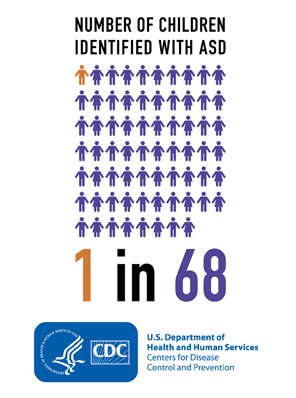CDC estimates 1 in 68 children has been identified with autism spectrum disorder
Latest snapshot shows proportion of children with autism and higher IQ on the rise
Press Release
Embargoed until: Thursday, March 27, 2014, 1:00pm ET
Contact: Media Relations
(404) 639-3286

Number of children identified with ASD: 1 in 68
The Centers for Disease Control and Prevention (CDC) estimates that 1 in 68 children (or 14.7 per 1,000 eight-year-olds) in multiple communities in the United States has been identified with autism spectrum disorder (ASD). This new estimate is roughly 30 percent higher than previous estimates reported in 2012 of 1 in 88 children (11.3 per 1,000 eight year olds) being identified with an autism spectrum disorder. The number of children identified with ASD ranged from 1 in 175 children in Alabama to 1 in 45 children in New Jersey.
The surveillance summary report, “Prevalence of Autism Spectrum Disorder among Children Aged 8 Years – Autism and Developmental Disabilities Monitoring Network, 11 Sites, United States, 2010,” was published today in the CDC’s Morbidity and Mortality Weekly Report. Researchers reviewed records from community sources that educate, diagnose, treat and/or provide services to children with developmental disabilities. The criteria used to diagnose ASDs and the methods used to collect data have not changed.
The data continue to show that ASD is almost five times more common among boys than girls: 1 in 42 boys versus 1 in 189 girls. White children are more likely to be identified as having ASD than are black or Hispanic children.
Levels of intellectual ability vary greatly among children with autism, ranging from severe intellectual challenges to average or above average intellectual ability. The study found that almost half of children identified with ASD have average or above average intellectual ability (an IQ above 85) compared to a third of children a decade ago.
“Community leaders, health professionals, educators and childcare providers should use these data to ensure children with ASD are identified as early as possible and connected to the services they need,” said Coleen Boyle, Ph.D., M.S. hyg., director of CDC’s National Center on Birth Defects and Developmental Disabilities.
The report also shows most children with ASD are diagnosed after age 4, even though ASD can be diagnosed as early as age 2. Healthy People 2020, the nation’s 10-year health objectives, strives to increase the proportion of young children with an autism spectrum disorder (ASD) and other developmental delays who are screened, evaluated, and enrolled in early intervention services in a timely manner.
“The most important thing for parents to do is to act early when there is a concern about a child’s development,” said Marshalyn Yeargin-Allsopp, M.D., chief of CDC’s Developmental Disabilities Branch. “If you have a concern about how your child plays, learns, speaks, acts, or moves, take action. Don’t wait.”
If you suspect that your child may have ASD:
- Talk to your child’s doctor about your concerns.
- At the same time, call your local early intervention program or school system for a free evaluation.
- It’s never too late to get help for your child.
CDC’s “Learn the Signs. Act Early.” program has joined with others across the federal government to promote developmental and behavioral screening through the Birth to 5: Watch Me Thrive campaign, which will be launched today. The program will help families look for and celebrate milestones; promote universal screenings; identify delays as early as possible; and improve the support available to help children succeed in school and thrive alongside their peers.
“More needs to be done to identify children with autism sooner,” said Boyle. “Early identification is the most powerful tool we have right now to make a difference in the lives of children with autism.”
Through the Affordable Care Act, more Americans will have access to health coverage and to no-cost preventive services, including autism screening for children at 18 and 24 months. Most health insurance plans are no longer allowed to deny, limit, or exclude coverage to anyone based on a pre-existing condition, including persons with autism spectrum disorder. Visit Healthcare.gov or call 1-800-318-2596 (TTY/TDD 1-855-889-4325) to learn more. Open enrollment in the Marketplace began October 1 and ends March 31, 2014.
For additional information on:
- Autism and Developmental Disabilities Monitoring (ADDM) Network and this report, visit www.cdc.gov/ncbddd/autism/index.html.
- CDC’s autism research, visit www.cdc.gov/ncbddd/autism/seed.html
- Community Report from the Autism and Developmental Disabilities Monitoring (ADDM) Network.
- Developmental milestone checklists and other resources to help families track their child’s development, visit www.cdc.gov/ncbddd/actearly/milestones/index.html.
- What to do if you are concerned about your child’s development, visit www.cdc.gov/ncbddd/actearly/concerned.html.
- State’s early intervention contact information, visit www.cdc.gov/ncbddd/actearly/parents/states.html.
- Birth to 5: Watch Me Thrive, is part of a coordinated federal effort to encourage developmental and behavioral screening and support for children, families, and the providers who care for them. Watch for updates at www.hhs.gov/watchmethrive (expected to be announced later today).
